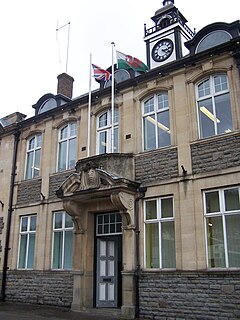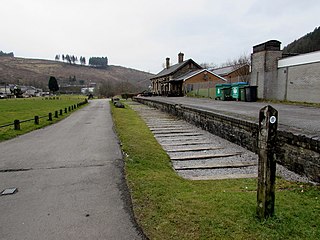Related Research Articles

The Taff Vale Railway (TVR) was a standard gauge railway in South Wales, built by the Taff Vale Railway Company to serve the iron and coal industries around Merthyr Tydfil and to connect them with docks in Cardiff. It was opened in stages in 1840 and 1841.

Mountain Ash is a town and former community in the Cynon Valley, within the County Borough of Rhondda Cynon Taf, Wales, with a population of 11,230 at the 2011 Census, estimated in 2019 at 11,339. It includes the districts and villages of Cefnpennar, Cwmpennar, Caegarw, Darranlas, Fernhill, Glenboi and Newtown, all within the historic county boundaries of Glamorgan. Aberdare lies about 4.5 miles (7.2 km) north-west, Cardiff 19 miles (31 km) south-east, and Penrhiwceiber a mile to the south-east. It divides into two electoral wards: West covers the town centre and the districts of Miskin, Darranlas, Fernhill and Glenboi, and East the districts of Cefnpennar, Cwmpennar, Caegarw and Newtown.

Ammanford railway station in Ammanford, Carmarthenshire, Wales, is 12 miles (19 km) north of Swansea on the Heart of Wales Line. The station opened in 1841 as a temporary terminus of the Llanelly Railway's line to Llandeilo, making it one of the country's earliest railway stations.

Treherbert railway station is a railway station serving the village of Treherbert in Rhondda Cynon Taf, Wales. It is the northern terminus of the Rhondda Line 23 miles (37 km) north west of Cardiff Central.
The Vale of Neath Railway (VoNR) was a broad gauge railway company, that built a line from Merthyr Tydfil and Aberdare to Neath, in Wales, chiefly to transport the products of the Merthyr iron industries to ports on Swansea Bay.
The South Wales Mineral Railway was a railway built to serve collieries in the upper Afan Valley, and bring their output to a dock at Briton Ferry, in South Wales. It opened in stages, in 1861 and 1863. It was built on the broad gauge and had steep gradients, including a rope worked incline near Briton Ferry.
In 1861 the Llynvi Valley Railway was opened in Glamorganshire, Wales, to convey mineral products to the Bristol Channel at Porthcawl. It adopted an earlier tramroad, the Duffryn Llynvi and Porthcawl Railway. The Llynvi and Ogmore Railway was opened in 1865, and the two companies amalgamated to form the Llynvi and Ogmore Railway in 1866. At first Porthcawl harbour was an important destination for onward transport, but this soon declined.
The Rhondda and Swansea Bay Railway was a Welsh railway company formed to connect the upper end of the Rhondda Fawr with Swansea, with the chief objective of transporting coal and other minerals to Swansea docks. It was incorporated in 1882, but at first the connection to Swansea from Briton Ferry was refused.
The Port Talbot Railway and Docks Company (PTR&D) was formed in 1894 to secure the means of bringing minerals, chiefly coal, to the harbour in South Wales. It took over the docks at Port Talbot that had been operated by the Port Talbot Company. It opened its main line in 1897 and reached a connection with the Great Western Railway Garw Valley line the following year. A branch line to collieries near Tonmawr also opened in 1898. The lines were extremely steeply graded and operation was difficult and expensive, but the company was successful. Passenger operation on the main line started in 1898, but this was never a principal part of the business. For some time most of the passenger train service was operated by a railmotor that was the largest ever to work in the United Kingdom. Also in 1898 the Ogmore Valleys Extension (OVE) line, a part of the PTR&D, was opened. It had been projected as a defensive measure against competitive incursion, and it led from Margam Junction towards Tondu.
Baglan Sands Halt railway station was a railway station on the Rhondda and Swansea Bay line which ran from the Rhondda Valley to Swansea on the Welsh coast in the county of Glamorgan.
Jersey Marine railway station was a railway station on the Rhondda and Swansea Bay line (R&SBR) which ran from the Rhondda Valley to Swansea on the Welsh coast in the county of Glamorgan. It lay 3 miles (4.8 km) east of Swansea.

Cymmer Afan railway station served the village of Cymmer, in the historical county of Glamorganshire, Wales, from 1885 to 1970 on the Rhondda and Swansea Bay Railway.

Cynonville Halt railway station served the village of Cynonville, in the historical county of Glamorganshire, Wales, from 1912 to 1956 on the Rhondda and Swansea Bay Railway.
Baldwins Halt railway station served the area of Crymlyn Burrows, in the historical county of Glamorganshire, Wales, from 1924 to 1933 on the Rhondda and Swansea Bay Railway.
Cardonnel Halt railway station served the village of Skewen, in the historical county of Glamorganshire, Wales, from 1905 to 1936 on the Swansea and Neath Railway.
Swansea Riverside railway station served the city of Swansea, in the historical county of Glamorganshire, Wales, from 1899 to 1933 on the Rhondda and Swansea Bay Railway.
Danygraig Halt railway station served the suburb of Dan-y-graig, in the historical county of Glamorganshire, Wales, from 1895 to 1936 on the Rhondda and Swansea Bay Railway.
Cwmneol Halt railway station co-served the village of Cwmaman, in the historical county of Glamorganshire, Wales, from 1906 to 1932 on the Vale of Neath Railway.
Ton Llwyd Halt railway station served the village of Aberaman, in the historical county of Glamorganshire, Wales, from 1906 to 1932 on the Vale of Neath Railway.
Pontwalby Halt railway station served the area of Pont Walby, in the historical area of Glamorganshire, Wales, from 1911 to 1964 on the Vale of Neath Railway.
References
| Preceding station | Disused railways | Following station | ||
|---|---|---|---|---|
| Cymmer Afan Line and station closed | Rhondda and Swansea Bay Railway | Cynonville Halt Line and station closed |